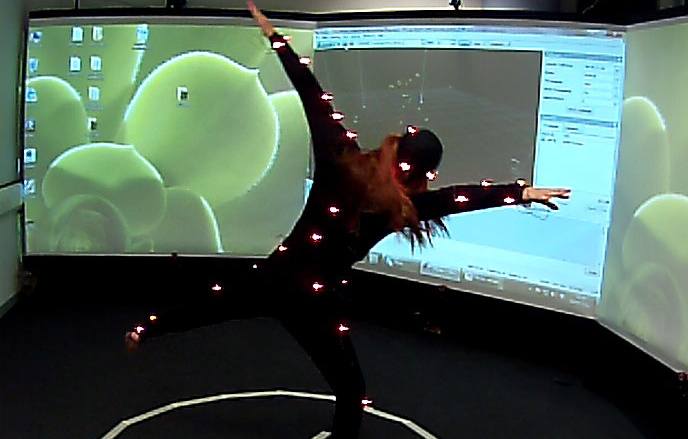The Virtual Dance Museum contains the first collection of high-quality 3D motion capture animations of folk dance creations using the latest technologies, allowing scholars and dance experts to study and analyse the world of intangible dance heritage.

© Virtual Dance Museum: A dancer performing in our motion capture studio, captured using active LED markers and the PhaseSpace X2 Impulse system
The Virtual Dance Museum serves as a repository for digitally storing and presenting folk dance creations as well as rare video materials held by local cultural institutions. The museum utilises emerging technologies for digitising, analysing, and holistically documenting intangible heritage dance creations to preserve and maintain European identity.
Advanced 3D character visualisation allows virtual navigation and e-learning applications to display dance motion data and metadata. The museum stores data holistically, enabling reusability through a Dance Motion Capture Database, and facilitating dance learning applications through gamification.
By employing motion capture systems, 3D scanners, and FHD cameras, they capture and archive expert dancers’ high-quality motion data performing traditional dances that are then publicly accessible in the Dance Motion Capture Database.
In collaboration with the Graphics Virtual Reality Lab and the University of Cyprus, they have established a motion capture laboratory at the CYENS Centre of Excellence using the new Phasespace Impulse X2 motion capture system with active LEDs:
The lab and how the magic works!
Using modulated LEDs the Phasespace Impulse X2E system captures 3D motion using 24 cameras. A pair of linear scanner arrays operate at high frequencies to capture any number of bright LED spots generated by the camera. Using a fast capture rate (up to 960Hz), the system can identify individual markers by combining information from several frames, recognising the marker from its unique modulation. The system captures 3D motion data for multiple characters simultaneously (up to 5 at a time), maintaining human proportions and the naturalness of the action, while still maintaining realistic motion. Thanks to its mobility, dance schools and studios can conduct motion capture sessions using this system. The system is capable of acquiring and synchronising several types of data.

© Virtual Dance Museum: An animated virtual character that performs the Antikristos dance and wears the traditional Cypriot uniform, at the Hadjigeorgakis Kornesios Mansion in the medieval town of Nicosia, Cyprus.
Our take
The Virtual Dance Museum is a space where experts and enthusiasts can study and analyse folk dance creations! It uses the latest technologies to store and illustrate the dances, and even has 3D character visualisation so people can learn dances with games! The museum is a great way to preserve intangible heritage.
I want to learn more:
Virtual Dance Museum
(may be under maintenance [07/12/2023])
Contact: dancemuseum@ucy.ac.cy

